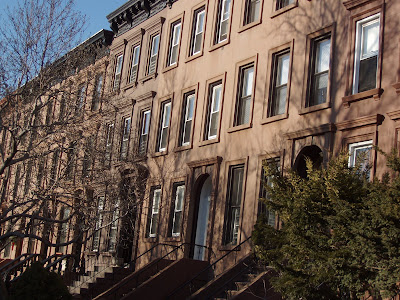
Always insightful and well researched, Steve Hart's comments on Brooklyn, Carroll Gardens and over-development have become some of my favorites.
His blog, Views From the Bridge, offers a very interesting analysis of all things political in our fair Borough.
I particularly enjoyed his comment circulating on the Carroll Gardens Neighborhood Association's Yahoo Group over the week-end. A previous poster had asked why it is taking so long to land-mark the neighborhood. This is Steve's answer, which I am reprinting here for all with his permission:
You have to accept the possibility that our pols don't want to change the status of the neighborhood because landmarking it will forever deny developers the ability to build as they wish. That is what landmarking does in Cobble Hill, Boerum Hill and parts of Brooklyn Heights. Many of our local pols get campaign support and other favors from developers which is a matter of public record. They can still build and make a good profit, but the huge bang for the buck is not in a deal where the public is vigilant and the law is behind them.
We are entering a recession which will last for several years. The effects will be slow in manifesting themselves and slower still in going away. So developers will push now for the fattest possible deals, and landmarking will not aid their cause. Of course they may also be fools because the huge prices they commanded for new apartments in recent years, are probably not going to be supportable as credit becomes harder to get and banks are finally put back under rational regulation.
The delay in helping Carroll Gardens is I think two fold. First, it is for the reason I stated above. The second is more complex. Carroll Gardens sits between the murky border of Red Hook and the brown field that is next to the F train. There are several important points to consider in realizing that:
1. There are, or were, buildings and blocks between the brown field and Red Hook that were in pretty bad shape at one time. These may not have been blighted. Blight is in the eye of the beholder to a great extent, but they needed work. So that was a justification for much of the construction that has already happened whether it made sense or not.
2. We are all used to the brown field but it is a continuing and serious hazard to the area along with being a huge waste of space. To fix it, I gather that most of the earth and all of the toxic waste would have to hauled away at huge expense. Doing that presents real hazards of its own. So pols look for incentives to pay for the scut work and wind up with an investment that pays big bucks to the developer. This cuts both ways. The brown field also depresses current property values, but it discourages high rise luxury housing being proposed by all but the most scurrilous developers. It is another example of where the free market cannot address certain social problems like toxic waste that the free market itself creates.
3. The boundaries of Red Hook are amorphous the further south you go. And so real estate people cheerfully create mythical places like Carroll Gardens West which are actually Red Hook East. There is nothing wrong with Red Hook, but it used to be a hard sell. So making less tasty areas seem like Carroll Gardens (Red Hook East) opens the door for developers to slash, burn and build in order to "save" an area that has problems. Under these circumstances, where does the border stop? At Hicks Street? At Clinton? At Court? At Columbia Ave? At our end of Smith St., the real estate people have come up with Bococa, or some such idiot acronym, for the various neighborhoods that include Boerum Hill as well as Carroll Gardens. That is all dunderheaded hype, but it confuses other matters.
All that is why it is so important to have real and meaningful zoning laws as well as building standards. More importantly, it is essential to have pols who truly have some interest in the good of the existing neighborhood, and not just out stumping for the party bigwigs. That means that our pols will often be at odds with developers who have bottomless pockets and an endless supply of highly polished, influential lawyers. At base, however, the issue is much simpler than politics or money. The wrong development can destroy a community and thus permanently kill what made it a valuable asset to its citizens, and to the City as a whole in the first place. Jane Jacobs notwithstanding, Penn Station is long gone and replaced by the current monstrosity that is about to be replaced itself. In another sense, Greenwich Village is gone at least in terms of the middle class, any sense of neighborhood, and the quality of life has declined into a sterile form of chic. Soho is even worse. To some extent, we are watching this happen under our noses on Smith and Court Streets as local merchants are forced out for generic urban chic. I shudder to think of the day when Caputo's is driven out of business so that Calvin Klein can sell shmata in its place. There will be no place left in Brooklyn to buy a fresh loaf of bread. Change is inevitable and it is not all bad. What is bad is when the people we elect abandon their constituents for self-serving financial and political advantages. Worse still is when they bend and distort the law to feed their own interests.
Steve Hart
For Home Page, click Pardon Me For Asking




0 comments:
Post a Comment